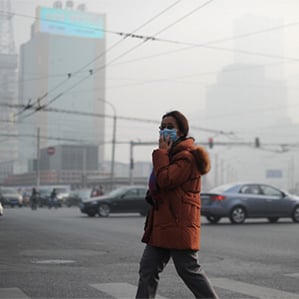How Artificial Intelligence Can Fight Air Pollution in China
Source: Will Knight

A woman wearing a face mask makes her way along a street in Beijing on January 16, 2014.
IBM is testing a new way to alleviate Beijing’s choking air pollution with the help of artificial intelligence. The Chinese capital, like many other cities across the country, is surrounded by factories, many fueled by coal, that emit harmful particulates. But pollution levels can vary depending on factors such as industrial activity, traffic congestion, and weather conditions.
The IBM researchers are testing a computer system capable of learning to predict the severity of air pollution in different parts of the city several days in advance by combining large quantities of data from several different models―an extremely complex computational challenge. The system could eventually offer specific recommendations on how to reduce pollution to an acceptable level―for example, by closing certain factories or temporarily restricting the number of drivers on the road. A comparable system is also being developed for a city in the Hebei province, a badly affected area in the north of the country.
“We have built a prototype system which is able to generate high-resolution air quality forecasts, 72 hours ahead of time,” says Xiaowei Shen, director of IBM Research China. “Our researchers are currently expanding the capability of the system to provide medium- and long-term (up to 10 days ahead) as well as pollutant source tracking, ‘what-if’ scenario analysis, and decision support on emission reduction actions.”
The project, dubbed Green Horizon, is an example of how broadly IBM hopes to apply its research on using advanced machine learning to extract insights from huge amounts of data―something the company calls “cognitive computing.” The project also highlights an application of the technology that IBM would like to export to other countries where pollution is a growing problem.
IBM is currently pushing artificial intelligence in many different industries, from health care to consulting. The cognitive computing effort encompasses natural language processing and statistical techniques originally developed for the Watson computer system, which competed on the game show Jeopardy!, along with many other approaches to machine learning (see “Why IBM Just Bought Millions of Medical Images” and “IBM Pushes Deep Learning with a Watson Upgrade”).
Predicting pollution is challenging. IBM uses data supplied by the Beijing Environmental Protection Bureau to refine its models, and Shen says the predictions have a resolution of a kilometer and are 30 percent more precise than those derived through conventional approaches. He says the system uses “adaptive machine learning” to determine the best combination of models to use.
| }
|